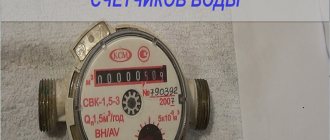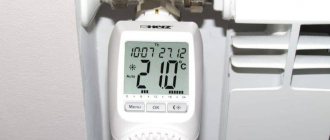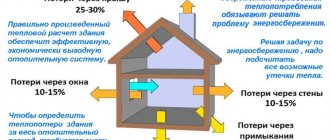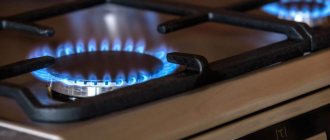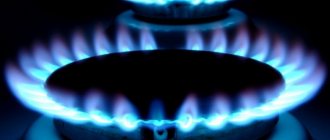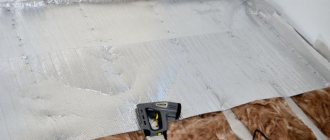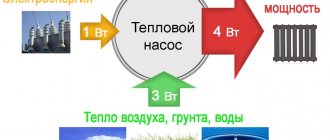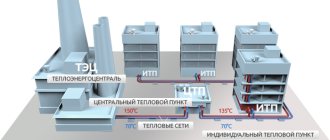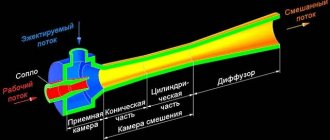Advantages of devices
In addition to the fact that installing individual heat meters in an apartment allows you to make payments depending on the readings, it undoubtedly has other advantages.
Heat meters for apartments
These characteristic advantages include:
- Private meter installations in a residential area allow you to regulate energy consumption depending on weather conditions. This is mainly in demand during the spring and autumn periods, when the temperature outside can change every day.
- Using the device, you can detect malfunctions in the coolant line (air pockets, blockages). This leads to an uneven supply of heat, which, of course, will immediately appear on the meter readings in the apartment.
- The installation of individual heat meters is also necessary because utility organizations calculate heating fees according to established standards, and not based on actual consumption. With the device, every month the heat in the apartment will be metered according to the readings.
Thus, the benefit of installing individual heat energy meters in an apartment is obvious.
On a note. A heat meter installed on hot water supply (DHW) will quickly justify its cost if the heating in the house is of poor quality. This is possible because if the meter readings are below 40˚, the calculation is made as for cold water (according to Government Decree No. 354).
Meanwhile, the installation of such devices has a number of features, and therefore it is necessary to pay special attention to them.
Heat meters in the apartment
Individual products have a small pipe flow area, not exceeding 20 mm, and the calculation occurs in the range from 0.6 to 2.5 m/h. This is allowed based on the coolant flow rate and the different water temperatures in the inlet and outlet pipes of the heating main.
Heat meter connection diagram for apartments
This happens in this way: a meter and a heat calculator are mounted on a liquid heating system device, the operation of which is provided in pairs. Two temperature sensors branch off from the second device, one of them is mounted on the inlet pipe, and the other on the outlet pipe.
As a result, the recording device collects the necessary readings from individual meters and, using special transformations, displays the amount of heat consumed on a scale.
Types of devices
If you plan to install equipment in an apartment, then before you start looking for a suitable company that will carry out the installation, you will need to make sure that the house has horizontal heating distribution, with a separate pipe running from the central riser to each floor.
With one of the two types of vertical wiring, it is irrational to install an apartment meter, because there are several risers in the house, and each of them will need to be installed with a separate device. In this case, common house equipment is installed, which records the heat meter readings of the entire building, and payment is made in accordance with the heated square meters of housing.
You can proceed to selecting the type of device. There is no ideal and you will need to compare the pros and cons of each of them in order to determine an acceptable option from four possible ones:
- Mechanical.
- Ultrasonic.
- Vortex.
- Electromagnetic.
Taking readings from a heat meter of any of these types has no fundamental differences and can only differ in terms of designations and the number of recorded values.
Classification and principle of operation of heat meters
The priority principle of operation of all similar products for metering thermal energy is readings at a certain water temperature.
Any heat accrual device consists of three components:
- Sensor;
- Unit for distribution, pressure and fluid resistance;
- Device for metering received thermal energy.
Scheme of the operating principle of a common house heat meter
In addition, meters are divided by purpose. They are available for individual and industrial (household) use.
Devices for houses with autonomous heating and apartments differ from house ones in more precise adjustment.
Heat energy metering devices for home use are divided into several types:
- Mechanical;
- Electromagnetic;
- Ultrasonic;
- Vortex devices.
To better understand their fundamental work, let’s look at each variety in more detail.
Tachometer instruments
The most affordable and understandable from the point of view of the average person are mechanical devices. Such devices use a rotating drum in the form of a small turbine as a meter.
Tachometer heat meter
It rotates from the pressure of the coolant, thanks to which water consumption is recorded. Typically, tachometer meters are equipped with two flow meters (on the inlet and outlet pipes), a resistance element and a heat calculator.
Sometimes devices are provided with pressure sensors. Such meters must have filters installed at the entrance. If the equipment is put into operation without them, then the presence of mechanical impurities (particles of sand, gravel, rust) will affect the operation of the device, and it will produce distorted readings.
Electromagnetic devices
This device's operating principle is based on the manifestation of electromagnetic induction. Inside the product there are several magnets that create a field of the same name.
Electromagnetic heat meter
As you know, water is a good conductor and when it passes through a magnetic field, an electric current is generated. Moreover, its value is directly proportional to the speed of fluid flow.
The generated electric current enters the computing node. And since the difference in current values is small, such devices require proper installation and special operating conditions.
Data readings will be distorted if the device is connected in violation of the required level (vertical instead of horizontal heating distribution in a high-rise building). And also at the junction there should not be a narrower throughput channel.
And one more factor that influences the reliability of information for coolants of this type is that the presence of iron in any form (scale, rust) is excluded in the water.
Ultrasonic heat metering
Meters with ultrasonic radiation are characterized by an unusual operating principle and high cost. The originality lies in measuring the passage of a wave through a liquid, depending on the speed of the coolant.
Ultrasonic heat meter
In other words, the flow rate is calculated by the time it takes for the signal to arrive from the radiation source to the receiver. In these products, strict placement of devices on the same line is important.
Vortex heat accounting
Turbulent-type devices are distinguished by a special measurement. In the path of the coolant in the pipeline there is a prism, which is an obstacle, and a vortex flow occurs.
Vortex heat meter
The number of vortex branches is recorded by special sensors and flow meters, which are located at a certain distance from the prism. And the stronger the flow speed, the greater the number of vortices formed.
Pros and cons of meters
Let's look at how to take readings from a heating meter in an apartment using the example of a mechanical type from the companies SensoStar, Gross and Supercal. Such a device is equipped with an impeller, which rotates as the coolant flows through. The part is connected to a sensor that reads the revolutions and determines the volume of liquid. To set the current flow rate, the device is equipped with a liquid crystal monitor, which shows the amount of thermal energy in Gcal, the recorded volume of flowing hot water, and the temperature of the medium in the inlet and return pipes.
Ultrasonic equipment measures the speed and wavelength that travels along the coolant flow and back. In accordance with the received data, a calculation occurs. This type of device is ideal for metering thermal energy consumption in closed and open water supply systems. It is advisable to take heat meter readings from equipment from German Sharky or Ukrainian Sempal.
Vortex devices analyze the vortices generated when a coolant flow passes through an obstacle. It is not difficult to take readings from a heat meter of this type, but you will need the help of a qualified specialist who understands all the capabilities of the equipment and knows how to operate it. Ultraheat, Karat and TSK products are recommended for installation.
Electromagnetic heating meter readings are more accurate because the analyzer makes calculations based on measurements of the current generated when hot water passes through a magnetic field. Data is captured directly, through a monitor with a control system, by connecting external drives to which archived data is copied, or through a remote connection. Among manufacturers, users also note “Primer”.
Product selection criteria
When choosing a thermal product, you need to focus not only on the cost and advertising description, but also on the operation of heat meters. However, they must meet the following characteristics:
- Water measurement range;
- Hydraulic losses after installation of the device. The diameter of the channel behind the meter should not be less than that before the device;
- Saving money. The cost of the product and all components required for installation;
- The prevalence of this device in the region of residence, reviews about it;
- Service of the selected counter.
Types of heat metering devices
Important. Without the appropriate certificate for the device, the management company will not take the product into operation, so when purchasing, be sure to request this document from the distributor.
In addition to the above parameters, such indicators of devices as the coolant inlet circuit and the working fluid itself are important for specialists, and they also need to know the limit values of the existing parameters for this coolant.
An important factor when choosing a device to be installed in an apartment is the model and cost of the selected product:
| Model | Type | Flow (nominal) | Market average cost, rub. |
| Engelmann Sensostar 2 | Electromechanical | From 1.5 to 2.5 m3/hour | 13 185 |
| Engelmann Sensostar 2U | Ultrasonic | From 1.5 to 2.5 m3/hour | 15 300 |
| Landis&Gir T-230 | Ultrasonic | From 1.5 to 2.5 m3/hour | 15 300 |
| Landis&Gir T-550 | Ultrasonic | From 0.6 to 2.5 m3/hour | 17 680 |
| Landis&Gir T-2WR6 | Ultrasonic | From 0.6 to 2.5 m3/hour | 17 600 |
| Apator ELF | Electromechanical | From 0.6 to 2.5 m3/hour | 12 300 |
Comparison table of popular models and prices
If you need more temperature, humidity, voltage, current and more
Having started with resource accounting, we went further - we organized the ability, through the KUB-Infra service, to monitor temperature and humidity, voltage and current levels, as well as remotely control anything at sites, for example, turn off the power to all sockets with one click.
What’s especially nice is that all these functions can be organized using the same KUB-Infra controller. The device provides all the appropriate inputs and outputs for sensors. Therefore, if, in addition to resource accounting, you need to organize something else, it is enough to purchase an appropriate sensor (temperature, humidity, current sensor, voltage control unit, etc.) and connect it to KUB-Infra. You will still be able to track the parameters there – in your personal account on the KUB-Infra service. Moreover, if the parameter goes outside the norm, the system will notify you about this by email or via messenger.
When using residential heat meters, you can significantly reduce heating fees. All this happens not only due to more accurate accounting of consumed heat, but also due to the fact that the consumer has an interest in more economical consumption of thermal energy. He begins to regulate the flow of coolant through his heating device in the apartment, as well as insulate walls, windows, etc.
Sometimes the benefit is obvious and the heat meter pays for itself in a matter of months, but the opposite often happens when the amount of energy consumed by the meter is greater than the standard indicators. We’ll talk about how to choose the right meter and the need to install it in this article.
What you should pay attention to and whether it is worth installing a meter. What needs to be taken into account when deciding to install a meter Registering a heat meter How to take readings correctly? You have decided to install a meter, what should you consider when choosing an installation organization?
Rules for the legal installation and operation of heat meters in an apartment
In order to install an individual heat meter legally in your apartment, you need to:
- Write an application addressed to the manager of the HOA, to which attach all the necessary documentation indicating ownership of the living space, a technical passport and a questionnaire with a survey of neighbors (consent from other residents is required when installing the meter).
- If the issue is resolved positively, technical specifications must be obtained.
- Contact a specialized company that is licensed to provide these services and give it the collected package of documents for approval.
- After receiving a positive response, order them to install a heat meter and all the necessary equipment.
- Write an application and draw up an agreement with the company that provides the supply of coolant to the house.
Heat meter installation sequence
Important. When installing a meter, an authorized representative of a specialized company must clearly show the calculation of the fee for using hot water and seal the meter.
How to correctly take and transmit readings for an apartment heat energy meter
Readings from residential heat meters should be taken by analogy with water meters. The only difference is that heat meters display several indicators on the indicator and to select the one you need, you should carefully read the operating instructions and strictly follow the manufacturer’s recommendations. After receiving the necessary information, the difference in readings for the previous and reporting periods should be entered into the receipt for payment for thermal energy, multiplied by the tariff established in the region, and the resulting amount should be paid.
Currently, modern heat metering devices are equipped with a built-in interface that allows you to read data automatically. For example, the domestically produced Kombik-T meter has a built-in radio antenna, which allows you to take readings from the device even without entering the apartment. It should be noted that a water meter (water meter) with a pulse output can be connected to such a device, which will allow you to take readings of water consumption (hot and cold) also without visual contact. Installing such metering devices will be a good solution for people who often go on business trips or trips and cannot personally meet the controller who comes to take readings.
From the information provided in this article, we can conclude that the procedure for taking and transmitting heat meter readings should be treated with a sufficient degree of responsibility.
Today I’ll talk about how to convert Gcal to kWh and back. The length, width, thickness of an object can be measured with a tape measure. The weight of an object can be determined by weighing it. But the amount of thermal energy cannot be measured either with a tape measure, or using scales or any other simple measuring instruments. Thermal energy can only be calculated mathematically. Like any quantity, thermal energy has its own units of measurement.
Meters, centimeters, millimeters, decimeters, kilometers, nanometers, etc. are units of measurement of length. As you may have guessed, kilograms, grams, tons, etc. are units of weight.
But Gcal, kWh, J are units of measurement of thermal energy. Moreover, just as meters can be converted into millimeters, and kilograms into grams, so Gigacalories can be easily recalculated by turning them into kWh and J. When you install your heat meter, you will have to learn how to convert Gcal into kWh and back.
You need to be able to do this in order to transfer the readings of this meter to your management company (management company). The fact is that some meters give readings only in Gcal, and some only in kWh. Management companies only accept meter readings in certain units. So we have to recalculate every month. Recounting is not a tricky business.
Let's say you want to convert 1 Gcal (one gigacalorie) into kWh, then you need to remember that one kWh is equal to 0.000860 Gcal
. Let's make a simple proportion:
1kWh = 0.000860 Gcal
Let's remember mathematics at school, and calculate what X is equal to Wh in this proportion: X = 1 kWh x 1 Gcal / 0.000860 Gcal = 1162.8 kWh
Or vice versa, you need to convert 1 kWh (one kilowatt hour) to Gcal. Again we make up the proportion, remembering that one kWh is equal to 0.000860 Gcal
.
1kWh = 0.000860 Gcal
Again we make calculations based on the usual proportion: X = 1 kW*h x 0.000860 Gcal / 1 kW*h = 0.000860 Gcal
So, we actually sorted out the conversion of Gcal to kWh. Everything is easy and very simple. Especially when you perform these simple calculations every month, first taking readings from the heat meter. But we will explain how to remove them in the next chapter.
By the way, I deliberately did not give any coefficients for converting Gcal to J and kWh to J. Simply because such a unit as J (joules) is practically not used now. It's like decimeters in the measurement of length. Decimeters seem to exist, you can and should know about them, and nothing more. The same epic with Joules.
Another subtlety you need to know about is the Kilo, Mega and Giga prefixes.
For example, kWh (kilowatt per hour), or MWh (megawatt per hour). Kilo means the number 1000, Mega means 1000000, but Giga means 1000000000.
1 kWh = 1000 Wh.
1 MWh = 1,000,000 Wh = 1,000 kWh.
1 Gcal = 1000000000 Cal = 1000 Mcal = 1000000 kcal.
What the consumer needs to know
- How often to take readings. According to the “Rules for Heat Carrier Accounting”, the consumer organization transfers data to the heat supply company for the whole month. But the information must be entered into the thermal energy control log at the same time every day.
- Frequency of checking meters. The inspection period for devices depends on the manufacturer, and this period can be set at two, three or every four years. The required information can be found in the specific product certificate.
- When installation is impossible or unprofitable. Despite all the visible advantages of a heat meter, installing it is not always profitable, and even in some cases it is simply impossible.
In many old houses, pipe routing is vertical and installing appliances on such risers for each apartment loses its meaning. In this case, the best option would be a common house meter, but this is only possible with the unanimous consent of all residents.
Common house heat meter
It is also unprofitable to install meters in panel high-rise and low-apartment one-story buildings due to their imperfect design.
Features of installation of meters
The owner of the apartment does not have the right to install heat metering devices, but he is interested in making sure that they are installed correctly. According to standard rules, the meter should be installed:
Heat meter for apartments: vertical installation
- Strictly horizontal or vertical. Its location depends on the purpose of the installation (apartment or house).
- The product's touch screen is always fixed upward.
- The flow channel of a working meter must be filled with liquid.
- The product must be installed according to the arrow located on its body.
All connections must be made using appropriate fittings, while maintaining the integrity of the rubber rings or gaskets.
Work on installing the device can be carried out by a specialized organization that has a license to provide such services.
Maintenance, repair and installation of UTE on the receipt - what is it?
UUET stands for Heat Energy Metering Unit and is a technical system consisting of measuring instruments, devices for metering thermal energy, the volume of its consumption, devices for monitoring and recording coolant parameters. This term is defined in Government Decree No. 1034 of November 18, 2013 “On commercial metering of thermal energy and coolant.”
But it should be noted that installing a heat metering unit is not the desire of the residents of the house; it is an obligation stipulated by legal norms. Therefore, the costs of its installation fall on the wallet of apartment owners and are reflected in the receipt for utilities.
Not all residents understand why it should be installed in an apartment building, but utility workers assure that in the end the benefits will become obvious. And there are several reasons for this:
- UUTE allows you to take into account the consumption of consumed resources for a specific house. In case of heat loss on the main line due to the fault of the supplier, losses will not be calculated from the consumer, but only actual costs will be taken into account.
- It becomes possible to control the quality of the supplied resource and its compliance with standards, to identify leaks and losses.
- The device makes it possible to record costs only for cold water during hot water supply outages.
The UUTE installation itself consists of the following data:
- the cost of the entire system of instruments and devices;
- installation of equipment.
The cost of installation directly depends on the condition of the pipeline in the house. Insertion may require upgrading them or removing part of the existing communications in order to make a proper installation. This can significantly increase the financial burden on the owners of apartments in the building and the amount in the receipt may differ in each of the residential buildings.
Breakdowns and repairs
Maintenance of the device is limited to maintaining it in working condition, regular inspection, and preventing causes of premature wear and breakdown. According to clause 80 of the Rules for commercial metering of coolant, all work on maintenance and monitoring the correct operation of the meter is carried out by the consumer. It does not require special care from the owner.
The lithium battery or batteries powering the device are not suitable for reuse and must be disposed of if they fail.
If any malfunction is detected in the operation of the meter, the consumer must notify the service company and the heat supply organization within 24 hours. Together with the arriving authorized employee, a report is drawn up, which is then submitted to the heat supply organization with a report on heat consumption for the corresponding period. If notification of a breakdown is not made in a timely manner, heat consumption is calculated in the standard way.
The service company will provide services for repairing or replacing the meter, and may install a replacement device during the repair. The cost of installation and dismantling, repair and other services is regulated by an agreement between the consumer and the service company.
Error Logging
As a standard, heat meters are equipped with a self-testing system that can detect operating inaccuracies. The computer periodically queries the sensors, and if they malfunction, it records the error, assigns it a code and records it in the archive. The most common reported errors are:
- Incorrect installation or damage to the temperature sensor or flow device.
- Insufficient battery charge.
- Presence of air in the flow part.
- No flow when there is a temperature difference for more than 1 hour.
Removing and installing a heating meter
Before installing a heating meter in an apartment or apartment building, specialists from specialized companies that have permits to carry out this type of work are invited. Based on the specific situation, they can undertake the following obligations:
- Develop a project.
- Submit documents to certain authorities in order to obtain permits.
- Install and register the device. In the absence of registration, payment for supplied heat is made according to established tariffs.
- Conduct tests and put the device into operation.
The developed project should include the following points:
- The type and design of the model, which is designed to work in a specific heating system.
- Necessary calculations for heat load and coolant flow.
- Diagram of the heating system with the installation location of the heat meter.
- Calculation of possible heat losses.
- Calculation of payment for the supply of thermal energy.
